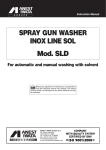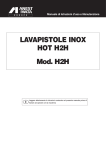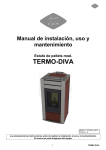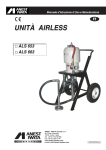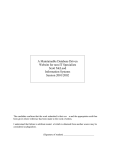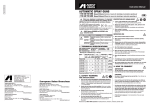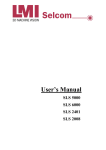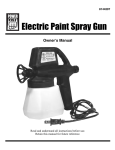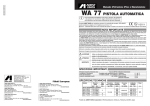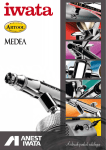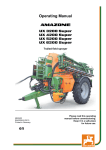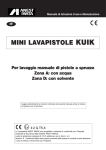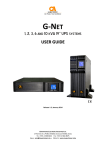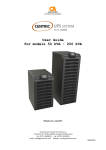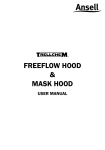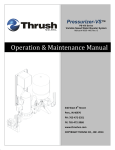Download SPRAY GUN WASHER INOX HOT H2H Mod. H2H
Transcript
Operating and Maintenance Manual SPRAY GUN WASHER INOX HOT H2H Mod. H2H Before use, adjustment or maintenance, it is important to read this instruction manual very carefully. The manual must be stored in a safe place for any future reference that may be necessary. GB SPRAY GUN WASHER INOX HOT H2H Mod. H2H TABLE OF CONTENTS 1. 1.1 1.2 1.2.1 1.2.2 1.3 1.4 1.5 1.6 1.7 INTRODUCTION ..........................................................................................................................................3 GUARANTEE................................................................................................................................................3 APPLICATION ..............................................................................................................................................4 IMPROPER USAGE......................................................................................................................................4 WASHING PRODUCTS ................................................................................................................................4 THE CE CERTIFICATION OF THE SPRAY-GUN WASHER ......................................................................5 DESCRIPTION..............................................................................................................................................6 IDENTIFICATION ........................................................................................................................................10 TECHNICAL SPECIFICATIONS ................................................................................................................10 SOUND LEVEL ..........................................................................................................................................11 2. 2.1 2.2 2.3 2.4 2.5 2.6 2.7 GENERAL RULES FOR SAFETY AND ACCIDENTAL PREVENTION ....................................................11 DANGER LEVELS AND TERMINOLOGY ................................................................................................11 WORKWEAR ..............................................................................................................................................12 ECOLOGY AND POLLUTION....................................................................................................................12 DANGER PLATES AND SIGNALS ............................................................................................................13 STANDARDS FOR SAFE OPERATION ....................................................................................................14 SAFE MAINTENANCE ..............................................................................................................................15 DEMOLITION AND DECOMMISSIONING ................................................................................................16 3. SHIPMENT AND UNLOADING ..................................................................................................................16 4. 4.1 4.2 4.3 4.3.1 4.3.1.1 4.3.1.2 INSTALLATION ..........................................................................................................................................16 POSITIONING ............................................................................................................................................16 CHECKS BEFORE EQUIPMENT INSTALLATION....................................................................................16 INSTALLATION ..........................................................................................................................................17 CONNECTIONS..........................................................................................................................................17 PNEUMATIC SYSTEM ..............................................................................................................................17 ELECTRIC SYSTEM ..................................................................................................................................18 5. 5.1 5.2 5.3 INSTRUCTIONS FOR USE ........................................................................................................................19 WATER HEATING CONTROL PANEL ......................................................................................................19 PREPARATION FOR THE USE OF THE SPRAY-GUN WASHER ............................................................20 WASHING GUNS AND ACCESSORIES WITH WARM WATER ................................................................20 6. SEPARATING PAINT FROM WATER ........................................................................................................20 7. 7.1 7.1.1 7.2 SPRAY-GUN WASHER SYSTEMS ............................................................................................................21 HYDROPNEUMATIC SYSTEM ..................................................................................................................21 OPERATION ..............................................................................................................................................22 ELECTRIC DIAGRAM ................................................................................................................................22 8. SAFETY DEVICES ....................................................................................................................................24 9. 9.1 9.2 9.3 9.4 MAINTENANCE AND PERIODICAL CHECKS ........................................................................................24 ORDINARY MAINTENANCE......................................................................................................................25 INSUFFICIENT VAPOUR EXHAUST..........................................................................................................25 CLEANING THE SMALL VENTURI PUMP ................................................................................................26 CLEANING THE NEBULIZER ....................................................................................................................26 10. SPARE PARTS LIST ..................................................................................................................................27 ANEST IWATA EUROPE srl reserves the property of the following manual. Any reproduction or disclosure of this manual without prior approval by the owner is expressly prohibited. For any claims, accidents or the like, the legally approved text will be the one in the manufacturer's language. ANEST IWATA EUROPE waives any and all liabilities for damages by misinterpretations or incorrect use caused by imperfect or imprecise translations. 2 SPRAY GUN WASHER INOX HOT H2H Mod. H2H 1. INTRODUCTION This manual contains the instructions for the installation, use and maintenance of the washing equipment SPRAY GUN WASHER INOX H2H referred hereinafter simply as Spray-gun Washer. This manual is an integral part to the product and should be kept with the due care in order to allow for its use and consultation during the life of the Spray-gun Washer. The regular operation, economy and safety of the Spray-gun Washer depends on the compliance with the instructions given in this manual. In case of loss or deterioration, submit your request for extra copies to: ANEST IWATA EUROPE S.r.l. Corso Vigevano 46 - 10155 Torino TEL.+39 011-24 80 868 - FAX.+39 011-22 74 406 Web: www.anest-iwataeu.com - E-mail: [email protected] The regular operation, economy and safety of the Spray-gun Washer depends on the compliance with the instructions given in this manual. It is mandatory to follow the procedures as described in this manual: This manual must be thoroughly read and understood before installing, using and operating or servicing the machine. The Spray-gun Washer must be used only to wash spray guns or small parts stained with water-based paint using warm water and special water-based detergents. All other uses of the Spraygun Washer not covered by this manual are to be considered inappropriate and are strictly forbidden. ANEST IWATA EUROPE declines any and all responsibility for damage to persons, animals and property deriving from improper use of the Spray-gun Washer or from failure to observe the instructions in this manual. The machine is supplied with an electric system with IP65 protection class in compliance with the EN 60529 norm and the following features: First digit 6: sealing against dust penetration. Second digit 5: protection against strong water jets in any direction • • 1.1 GUARANTEE Upon delivery of the Spray-gun Washer, it is necessary to make sure that no damages have occurred during shipment and the supply of accessories is complete and undamaged. Claims must be filed within 8 days of delivery. The buyer is eligible for the guarantee coverage only when he has complied with the guarantee conditions listed below. La ANEST IWATA EUROPE guarantees its products under the following conditions: a) The Spray-gun Washer is guaranteed for a period of one year from the date of purchase as certified by a delivery document issued by the Dealer. When the customer requests guarantee service, he must always specify the model, serial number and year of manufacture of the appliance. b) The guarantee covers free replacement or repair of the appliance component parts which are recognized to have manufacturing defects without any charge for labour. c) Guarantee services are performed at the manufacturer's factory or at authorized service centres. The appliance must be sent already prepaid to them and shall be returned to the customer at his own expense and risk. If any intervention by technicians is requested under guarantee coverage at the customer's installation site, then the customer shall be charged for the transfer time, for mileage and for all board and lodging expenses according to the valid fees applied by the Service Centre. No charge is made for the time required to repair and replace parts. d) The manufacturer waives all liability for any damage that may directly or indirectly be caused to persons or property resulting from failure to comply with all the provisions in the instruction manual. In particular, this regards failure to comply with warnings about placing, installing, operating and maintaining the appliance. The present guarantee does not cover any reimbursement for direct or indirect damage due to appliance down-time. Guarantee coverage is only valid when payments are all in due order. e) This agreement is governed by current law in the Republic of Italy. Any controversy deriving from this agreement shall be settled by the Court in Torino, Italy. 3 SPRAY GUN WASHER INOX HOT H2H Mod. H2H In addition to the cases stated above, guarantee coverage is waived in the following cases: • Whenever the Spray-gun Washer has been handled or operated incorrectly by the operator. • Whenever the damage is due to insufficient maintenance. • Whenever the Spray-gun Washer has been damaged by modifications following repairs done without ANEST IWATA EUROPE's consent or the installation of non-original spare parts. • Whenever the owner/operator fails to comply with the instructions given in this manual. • Whenever corrosive detergents are used that do not comply with legal standards or not included among those listed by ANEST IWATA EUROPE. 1.2 APPLICATION The Spray-gun Washer has been designed and built only to wash spray guns or small parts stained with water-based paint using warm water and specific water-based detergents. The weight of pieces to be washed should not exceed 10 kg weight. 1.2.1 IMPROPER USAGE All other uses not covered or non-complying with this manual are to be considered improper and are strictly forbidden. The following uses are not allowed: • It is forbidden to wash objects or products not covered by this manual. • It is forbidden to wash Spray-guns or small parts using detergents with technical specifications different from those included in this manual. • It is forbidden to use inflammable solvents for any purposes. • It is forbidden to use the Spray-gun Washer within environments in which potentially explosive gas mixtures, vapours or dusts may occasionally generate. WARNING The Spray-gun Washer must be used exclusively for the purpose for which it was designed and built. All other uses not covered by this manual are to be considered inappropriate and are strictly forbidden. ANEST IWATA EUROPE declines any and all responsibility for damage to persons, animals and property deriving from improper use of the Spray-gun Washer and/or from failure to observe the instructions in this manual. Given the fact the Spray-gun Washer is an appliance manufactured to wash Spray-guns using clean water and water-based detergents, i.e. free from flammable components, there are no restrictions as regards the surface area occupied by the Spray-gun Washer and the machines positioned near it. 1.2.2 WASHING PRODUCTS Spray-guns and accessories can be washed using: • Clean water • Water with “AQUA REVIVE” detergent by ANEST IWATA EUROPE, or • Water-based liquid detergent with the following specifications: pH ranging from 6.5 and 12; exclusion of flammable components or, if any, not exceeding 8%. The above products must comply with the anti-pollution regulations provided by the law in force in the Country where the Spray-gun Washer is used. WARNING It is forbidden to use solvent or any other flammable product to wash Spray-guns. 4 SPRAY GUN WASHER INOX HOT H2H Mod. H2H 1.3 THE CE CERTIFICATION OF THE SPRAY-GUN WASHER Directive 98/37/EC stresses the minimum requirements machinery must be brought in line with, in order to be placed on the European Union market. All machinery covered by this Directive may be placed on the market and put into service only if they do not endanger the health and safety of persons, domestic animals or property. The Spray-gun Washer is a machine designed to wash Spray-guns and is not included in any of the categories indicated in the list attached to the Directive (Annex IV - highly dangerous machinery). Prior to placing its machines on the market and in order to demonstrate that the machines are in compliance with the provisions set forth by Directive 98/37/EC, ANEST IWATA EUROPE guarantees that all the tests and controls required by the reference regulations (including the risks analysis) have been conducted and meet the essential safety and health requirements as provided for by Annex I of the aforementioned Directive. The technical construction file that includes the fundamental project data and all the specifications relating to the machine safety has been drawn in compliance with Annex V of Directive 98/37/EC, and is made available to any controls by the inspection authorities - prior to detailed notification, as provided for by the ruling provisions in this matter. Given that the machine has been designed and built in compliance with the provisions set forth by directive 98/37/EC, and can be safely operated under the conditions stated by this manual, ANEST IWATA EUROPE puts the Spray-gun Washer on the market provided with: • CE Mark • EC Declaration of Conformity • Instructions for use (User's Manual) ANEST IWATA EUROPE guarantees that the Spray-gun Washer design and construction comply with the requirements set forth by the application of the European legal provisions referring to this matter, and precisely with the following directives: • Directive 89/336/EEC and subsequent additions (Electromagnetic compatibility) • Directive 98/37/EC (Safety of Machinery). • Directive 2006/95/EC (Low voltage) The following European standards and technical norms have been used by the manufacturer and can be a reference in order to verify the conformity with the legal European provisions: - EN 294:1992: SAFETY OF MACHINERY - Safety distances to prevent danger zones being reached by the upper limbs. - EN 349:1993: SAFETY OF MACHINERY - Safety of machinery. Minimum gaps to avoid crushing of parts of the human body. - EN 418:1993: SAFETY OF MACHINERY - Emergency stop equipment - Functional aspects - Principles for design. - EN 614-1:1995: SAFETY OF MACHINERY - Ergonomic design principles. Part 1: Terminology and general principles. - EN 842:1996: SAFETY OF MACHINERY - Visual danger signals. General requirements, design and testing. - EN 954-1:1996: SAFETY OF MACHINERY - Safety-related parts of control systems - Part 1: General principles for design. - EN 983:1996: SAFETY OF MACHINERY - Safety requirements for fluid power systems and their components. Pneumatics. - EN 1050:1996: SAFETY OF MACHINERY - Principles for risk assessment. - EN ISO 3746:1995: ACOUSTICS - Determination of sound power levels of noise sources using sound pressure - Survey method using an enveloping measurement surface over a reflecting plane. - ISO 7000:1995 GRAPHICAL SYMBOL FOR USE ON EQUIPMENT - Index and synopsis. 5 SPRAY GUN WASHER INOX HOT H2H Mod. H2H - EN ISO 11202:1995: ACOUSTICS - Noise emitted by machinery and equipment - Measurement of emission sound pressure levels at a work station and at other specified positions - Survey method in situ. - EN ISO 12100-1:2003: SAFETY OF MACHINERY - Basic concepts, general principles for design Part 1: Basic terminology, methodology. - EN ISO 12100-2:2003: SAFETY OF MACHINERY - Basic concepts, general principles for design Part 2: Basic terminology, methodology. - EN ISO 12100-2:2003: SAFETY OF MACHINERY - Basic concepts, general principles for design Part 2: Basic terminology, methodology. - EN 12921-1:2005: MACHINES FOR SURFACE CLEANING AND PRE-TREATMENT OF INDUSTRIAL ITEMS USING LIQUIDS OR VAPOURS - Part 1: Common safety requirements. - EN 12921-2:2005: MACHINES FOR SURFACE CLEANING AND PRE-TREATMENT OF INDUSTRIAL ITEMS USING LIQUIDS OR VAPOURS - Part 2: Safety of machines using water based cleaning liquids - EN 55022:1998: CISPR 22 - Information technology equipment. Radio disturbance characteristics. Limits and methods of measurement. - EN 60204-1:2006-06: SAFETY OF MACHINERY - Electrical equipment of machines. Part 1:General requirements. - EN 60529: 1997 DEGREES OF PROTECTION PROVIDED BY ENCLOSURES (IP code) - EN 61000-6-1:2001 ELECTROMAGNETIC COMPATIBILITY - Part 6-1: Generic standards - Immunity for residential, commercial and light-industrial environments. - EN 61000-6-3:2001 ELECTROMAGNETIC COMPATIBILITY - Part 6-3: Generic standards - Immunity for residential, commercial and light-industrial environments. 1.4 DESCRIPTION The pneumatic Spray-gun Washer with electrical water heating consists of a stainless steel container (see fig. 1A) designed to carry out: • A manual washing with warm detergent enabled by a small Venturi pump (pos.21 fig.1A). • A final washing with clean water by means of a nebulizer (pos.22 fig.1A) • A brush (pos.36 fig.1), connected to the workshop water system for the final washing of Spray-guns, for washing the collecting container (pos.2 fig.1A) after having discharged dirty water, and to fill tanks once again with clean water (pos.2-W53 fig.1A). • A grid top (pos.6C fig.1A) to drop and drain the Spray-guns to be washed. • A heated sink (pos.2 fig.1) to collect the used detergent, and fitted with a mixing unit (pos.35 fig.1A) to mix coagulating powder. • A tap (pos.30 fig.1A) to discharge the product and the coagulated paint in the filter (pos.W50 fig.1A). • A tank (pos.W53 fig.1A) to collect filtered water. The Spray-gun Washer is supplied with hoses (pos.7-23 fig.1A) for suction and discharge of the various liquids from the containers. From the upper control panel, the operator can control: • The small pump (pos. 19 fig. 1A) for warm detergent • The clean water nebulizer (pos. 18 fig.1), • Clean water from the workshop water system (pos.18C fig.1). • The vapour exhaust (pos.41 fig.1). • The regulation of the air flow for mixing water with coagulating powder (pos. 1 fig. 1) 6 SPRAY GUN WASHER INOX HOT H2H Mod. H2H Description of the Spray gun washer (See fig. 1A-1B): 1 2 3 4 4A 6C 7 7F 10 11A 12 15 16 18 18C 19 21 22 22C 23 23C 23R 30 35 36 41 W50 W51 W52 W53 74 76 80 81 82 83 84 85 86 87 88 89 90 91 92 93 94 95 96 97 98 99 Regulator valve of mixing air flow Heated tank for collecting liquids Lower door magnet Spray-gun feeding hose Blowing gun Grid top Small pump feeding hose Small pump feeding filter Air outlet fitting Lower door Air inlet fitting with filter Vapor exhaust nozzle Vapor stack (ø 120 mm) Nebulizer check valve Water control lever connected to the water mains. Check valve of warm water small pump Warm water small pump Nebulizer Water outlet fitting Nebulizer feeding hose Water inlet fitting Water flow regulation valve (to be connected to the fitting 23C and the water mains). Sink discharge valve Air diffuser to mix water and coagulating powder Washing brush Exhaust command valve Pre-filter bag Filter bag Pierced container Clean water container External earth cable Rear pipe guide Electrical panel Power supply cable Pierced screw Sink bottom protection Sink bottom fitting Electric resistance Operating sensor and safety sensor Probe bracket locking nut Thermal insulation Resistance protection Protection reinforcement Protection locking nut Max temperature thermostat Internal earthing cable Resistance power supply cable Rear cover Probe cable Small thermal insulation Probe brackets Packing and forwarding protection to be removed before installation 7 SPRAY GUN WASHER INOX HOT H2H Mod. H2H Figure 1A NB. When ordering spare parts, always indicate: MODEL - SERIAL NUMBER - CONSTRUCTION YEAR 8 SPRAY GUN WASHER INOX HOT H2H Mod. H2H Figure 1B NB. When ordering spare parts, always indicate: MODEL - SERIAL NUMBER - CONSTRUCTION YEAR 9 SPRAY GUN WASHER INOX HOT H2H Mod. H2H 1.5 IDENTIFICATION (See fig. A) Every spray gun washer has a CE identification plate that shows: ABCDEFGHILM- Manufacturer's brand. Maximum Working Pressure Manufacturer's name and address CE Mark. Max Amount of washing product Protection Level Year of manufacture Voltage Serial number Electric Supply Model N.B.: The G - I - M data listed in the identification plate must be always specified when calling for service and/or supply of spare parts. C A D B E F G M L I H Fig. A 1.6 TECHNICAL SPECIFICATIONS Description Mass (Weight). Dimensions of the Spray gun washer Height Width Depth Max operating pressure Feeding air operating pressure. Recommended pressure once the SPRAY-GUN WASHER is ON. Diameter of the holes of the suction nozzle (pos.15 fig.1A). (Mean) Air consumption at 6 bar. Fume chute diameter (pos.16 fig.1A). Air speed at hood entrance (8 bar). Air capacity at chute exit ( 8 bar). Stainless steel sink water capacity (pos.2 fig.1A). Lower container capacity (pos.W53 fig.1A). Voltage/frequency. Electric resi stance Temperature of detergent inside sink (pos.2 fig.1A) Electric system protection level 10 Unit of Measure Value kg 43 mm mm mm bar bar bar mm Nm3/h mm m/sec m3/h dm3(litres) dm3(litres) V/Hz W °C - 1410 450 670 10 6˜10 8 1,5 9 120 0.51 366 50 70 230/50 980 38-44 IP 65 SPRAY GUN WASHER INOX HOT H2H Mod. H2H 1.7 SOUND LEVEL The sound level emitted by the Spray gun washer has been measured under working conditions using a sound level meter with integrator. Measures were taken by a skilled laboratory technician in accordance with EN ISO standard 3746. Results are as follows: • Acoustic pressure equivalent average level: LpAm = 78,2 dB (A) • Acoustic pressure level at the operating post: LpA = 85,9 dB (A) • Conventional Acoustic pressure level: LwA = 93,1 dB (A) 2. GENERAL RULES FOR SAFETY AND ACCIDENTAL PREVENTION 2.1 DANGER LEVELS AND TERMINOLOGY The safety of both the operator and the persons exposed to the machinery is the primary concern of the designer and builder of the machine. In designing a new Spray gun washer, every attempt is made to prevent any possible situation of danger and risks connected with use of the machine, by applying the appropriate solutions to make the equipment as safe as possible. It is therefore recommended that you read this manual carefully, especially this section, which concerns the safety norms, and that you avoid inopportune behaviour or behaviour that is contrast with the instructions contained herein. Pay attention to the hazardous warnings indicated in this Manual and comply with all the safety provisions. There are three severity levels of hazards: DANGER This signal communicates that improper performance of the procedures herein will result in severe injuries, death or prolonged medical treatments. The DANGER signal is used for extreme hazardous levels WARNING This signal communicates that improper performance of the procedures herein could result in severe injuries, death or prolonged medical treatments. The WARNING signal is used for lower levels of hazard than in DANGER. CAUTION This signal communicates that improper performance of the procedures herein could damage the machine. The CAUTION signal is used for a lower level of hazard than in DANGER and WARNING. Read carefully the following standards. Failure to comply could result in personal injuries or damages to persons, animals and property. ANEST IWATA EUROPE waives all liability for any damage that may directly or indirectly result from failure to comply with the safety and accident prevention standards herein. ANEST IWATA EUROPE also declines all liability for damage caused by improper use of the SPRAY-GUN WASHER and/or modifications to the machine made without the manufacturer's authorisation. 11 SPRAY GUN WASHER INOX HOT H2H Mod. H2H TERMINOLOGY: The following definitions are provided for the terminology used in this manual. The correct explanation of this terminology is necessary to ensure perfect understanding of situations of danger that could arise while using the machine with direct effects for the operator, and the persons exposed to the machine itself: • OPERATOR: In a general sense, the person in charge of transporting, installing, adjusting, operating, cleaning and performing ordinary maintenance on the SPRAY-GUN WASHER (Art. 1.1.1., para. 1, attachment I, directive 98/37/EC). • EXPOSED PERSON: Any person next to or inside a dangerous area, for any reason whatsoever (Art. 1.1.1., para 2, attachment I, directive 98/37/EC). • DANGEROUS AREA: Any area next to or inside the machine, where the presence of an exposed person constitutes a risk for the safety and health of said person (Art. 1.1.1., para 3, attachment I, directive 98/37CE). • OPERATOR: The person, organisation or company responsible for the training of workers who must operate the equipment, which has purchased the SPRAY-GUN WASHER in any form or has rented the equipment, which must be used only for the purposes intended by the manufacturer. • SPECIALISED TECHNICIAN: An especially trained and qualified person to perform maintenance intervention or repairs, which require special in-depth knowledge of the machine, its operation, safety devices, dangerous areas and methods of intervention, who is therefore capable of recognising and avoiding dangers arising from use of the machine. • pH: Measurement that expresses the acidity of a solution. The pH scale ranges from 0 to 14. For pure water the pH value = 7. When pH is above 7 the solution in alkaline; when it is less than 7 the solution is acid. 2.2 WORKWEAR The type of workwear depends on the work that must be carried out. When using the SPRAY-GUN WASHER and relevant products, comply with the regulations below: • The operator must wear solvent-proof rubber gloves to prevent contact between his hands and the products used for washing. • The operator must always wear protective eyewear to prevent the solvent coming into contact with his eyes. • The operator must use a protective mask to avoid inhaling gas and dust. 2.3 ECOLOGY AND POLLUTION • The Spray gun washer must not be used to wash or degrease objects designed to come into contact with foodstuffs. • Comply with Laws in the country where the Spray gun washer is installed regarding use and disposal of washing products and with the recommendations given by the manufacturer of these products. 12 SPRAY GUN WASHER INOX HOT H2H Mod. H2H 2.4 DANGER PLATES AND SIGNALS The Spray gun washer carries the manufacturer's identification plate as well as pictograms (labels) that warn against any machine's residual risks that may occur. Figure 2 indicates the danger signs and signals and shows where the Manufacturer's identification plate is normally placed. These warning signals have the following meanings: 1. Manufacturer's identification plate: Manufacturer's brand, CE mark, model, serial number and year of construction, air pressure, max quantity of washing product, power supply specifications, voltage, level of protection. 2. General danger. 3. Warning: It is mandatory that you carefully read the instructions manual before operating the machine. 4. Warning: It is forbidden to use open flames and to smoke near the Spray-gun Washer. 5. Warning: It is mandatory that you put on a protective mask before working with the machine. 6. Warning: It is mandatory that you put on solvent-proof rubber gloves before you start working. 7. Warning: It is mandatory that you put on protective eyewear before you start working. 8. Danger: It is mandatory that you power off the machine and disconnect the compressed air supply before starting any maintenance or repair operations in the Spray gun washer. 9. Warning: It is mandatory that you check hoses ensuring they are well fitted in the drums before starting any operation. 10. Caution: It is recommended that you check the water level in the containers periodically to avoid overflows. 11. Burning danger: It is forbidden to carry out any operation inside the empty sink (pos.2 fig.1A) when the machine is on. 12. Warning: It is mandatory that you power off the machine before discharging water from the sink (pos.2 fig.1A). 1. 11. 12. Figure 2 13 SPRAY GUN WASHER INOX HOT H2H Mod. H2H 2.5 STANDARDS FOR SAFE OPERATIONS The SPRAY-GUN WASHER has been designed and built to be used in ventilated environments where potentially explosive atmospheres from gas mixture, vapours of powder are not to be expected. The use of the Spray-gun Washer is strictly forbidden to anyone who has not fully read and understood the contents of this instruction manual • • It is strictly forbidden to let the Spray-gun Washer be used by anyone who is not properly skilled or duly trained or is not in perfect health. • It is forbidden to use the Spray-gun Washer following instructions which are not included in the final application: the appliance must be used exclusively to wash Spray-guns, small containers and objects stained with water-based paint. • It is forbidden to use detergents or products which do not comply with the specifications included in this manual, and with the law during the washing cycle. • It is forbidden to use detergents having pH values lower than 6.5 or exceeding 12. If the mixture contains flammable substances, their quantity must be limited to 8%. • It is forbidden to use solvents or other flammable products. • It is forbidden to put unsuitable objects and weights above 10 Kg on the grid top (pos. 6C fig.1) of the Spray-gun Washer. • It is forbidden to run the machine once it has been powered on, without the internal protection (pos. 83 fig. 1B) and external protections (pos.89-95 fig.1B). • It is forbidden to run the machine once it has been powered on, without liquid inside the sink (pos. 2 fig. 1A). • It is forbidden to drain the detergent from the sink (pos. 2 fig.1A) before the machine has been powered off from the control panel (pos. 80 fig. 1A). • It is forbidden to continually disconnect and reconnect the air supply hose from its connection (pos.12 fig.1A). • It is forbidden to use the Spray-gun Washer in environments where potentially explosive atmospheres formed by mixtures of gas, vapour or dust may be occasionally expected and for very short periods. • It is forbidden to connect the electric system of the Spray-gun Washer directly to the electric system conductors: a failure may result in injuries or damage the control panel. • It is forbidden to make any junctions along the power cable. • It is forbidden to run the machine when pictograms communicating danger (self-adhesive labels) applied to the machine are missing or damaged. If this is the case, immediately replace them with other labels with the same meaning. • It is forbidden to perform cleaning or ordinary maintenance operations when the Spray-gun Washer is powered on and ready to be used: power off the machine before any such operations. • It is forbidden to weld, flame cut or perforate the Spray-gun Washer case. • It is mandatory that you position the machine within a facility providing shelter against water and ice: the Spray-gun Washer has been designed to work only indoor. • It is mandatory that before using the Spray-gun Washer all safety devices be checked for integrity. • It is mandatory that before using the Spray-gun Washer, you connect the external ground wire (pos 74 fig. 1A) to the workshop mains. • It is mandatory that, while loading and unloading the container, you pay attention not to spill the solvent on the workshop floor. • It is mandatory that, before using the Spray-gun Washer, the water feeding hoses (pos.7-23 fig.1A), are firmly inserted in their respective containers - being careful not to bend them. Make sure that they are not damaged before using the Spray-gun Washer. • It is mandatory that, before using the Spray-gun Washer you ensure that the cover (pos.46-95 fig. 1A-1B) closes perfectly the inspection hole • It is mandatory that you clean periodically the grid top (pos.6C fig.1A). • It is mandatory that you power off the machine from the control panel (pos. 80 fig. 1A) before draining the detergent from the sink (pos. 2 fig. 1A). • It is mandatory that, to avoid overflows, you periodically check that the water level in the sink (pos. 2 fig. 1A) is not above its normal level. • It is mandatory that, at least once a month, you empty the dirty water container (pos. 2 fig. 1A) and you clean the bottom of the sink removing thoroughly sludge to avoid incrustations. 14 SPRAY GUN WASHER INOX HOT H2H Mod. H2H • It is mandatory that you have the Spray-gun Washer serviced only by qualified, skilled and competent personnel in compliance with the instructions included in this manual. • It is mandatory that you verify the earth cable of the Spray-gun Washer after connection to the electric system. A failure or incorrect connection of the earth cable may result in severe injuries and ultimately death. • It is recommended that you don't have nylon, plastic, glass wool, GRP or similar products next or over the Spray-gun Washer to avoid electrostatic charges. • It is recommended that, before operating the machine, you become familiar with the control devices and their functions. • It is recommended that , should skin or eyes come in contact with washing products, you rinse them abundantly with water. • It is recommended that, if the Spray-gun Washer remains unused for a long period of time, you empty the dirty water sink (pos. 2 fig. 1A) and rinse the washing sink (pos. 2 fig. 1A) with clean water. • It is recommended that you replace the dirty detergent whenever needed: you can regenerate it with the coagulating powder and the appropriate kit, or hand it to waste recovery companies. • It is recommended that, before discharging the dirty detergent from the sink (pos. 2 fig. 1A) through the valve (pos. 30 fig. 1A), you ensure that the 2 containers (pos. W52-W53 fig. 1A), the prefilter (pos. W50 fig. 1A) and the filter (pos. W51 fig. 1A) are positioned below. Open the discharge valve (pos. 30 fig. 1A) and drain slowly the dirty water to avoid overflows. DANGER It is forbidden to spray and/or blow with the gun pointed to the operator or other persons: THIS COULD CAUSE SERIOUS DAMAGE TO HEALTH. 2.6 SAFE MAINTENANCE The directions below guarantee the ideal performance and safe operations of your Spray-gun Washer. • It is forbidden to remove or tamper safety devices. • It is forbidden to carry out cleaning, lubrication, greasing or ordinary maintenance when the machine is powered on and ready for use: disconnect the electric power and compressed air supply before any such operations. • It is forbidden to weld, flame cut or perforate the structure. • It is mandatory to check the safety devices for integrity when you start operating. • It is mandatory to check periodically the preservation conditions of the hoses: they must not show cuts or clear signs of abrasions. If needed, immediately replace them with hoses of similar specifications. • It is mandatory to clean the machine thoroughly, following the instructions contained in this manual, and to replace damaged or worn out parts during maintenance. • It is mandatory to have the machine serviced only by qualified, skilled and competent staff following the instructions contained in this manual. • It is mandatory to periodically check the pictograms of danger signals (self-adhesive labels): they directly provide essential communication of dangers and actions to undertake in order to avoid injuries or dangerous situations. They must be replaced when missing or even partially damaged. • It is recommended that you always use original spare parts during maintenance or repair operations. • It is recommended that you store and keep this instructions manual for the entire lifespan of this machine. 15 SPRAY GUN WASHER INOX HOT H2H Mod. H2H 2.7 DEMOLITION AND DECOMMISSIONING Upon demolition or decommissioning of the Spray gun washer, we recommend that you take the necessary precautions to avoid danger to exposed persons and the risk of environmental pollution: • Power off the Spray gun washer and disconnect the compressed air supply, and discharge the residual energy accumulated. • Residual liquid possibly left in the sink and hoses of the equipment must be carefully drained. • The other parts of the Spray gun washer must be treated in accordance with the regulations for special waste. Proceed by disassembling the machine: group the various units and parts into homogeneous lots and provide for their disposal separately, in accordance with environmental protection laws in the country where the machine is installed. In general, please bear in mind that: • Plastic or rubber parts are special waste. • Ferrous scrap and carpentry are special waste. 3. SHIPMENT AND UNLOADING The Spray gun washer is shipped in a carton with the markings < fragile > and < keep upright >. It is palletized and can be easily handled with a fork lift to the installation area. Remove the cardboard and the pallet, and check that the machine has not been damaged during the transport. 4. INSTALLATION 4.1 POSITIONING When deciding where to position and install the machine, you should carefully consider the points here below. The machine must be positioned indoors in a safe, obstacle-free area, sheltered against weather conditions. The area should be well-lighted The environment must be suitable for housing the machine, and free from open flames, sources or processing systems that may develop gas or flammable or explosive vapours. The IP65 protection electric system case of the Spray-gun Washer should not be installed in environments where there might be releases of gas and/or flammable vapour or explosive mixtures The Spray-gun Washer room temperature should be ranging from 15° to 45°C. • • • • 4.2 CHECKS BEFORE EQUIPMENT INSTALLATION Before installation, check and, if needed, adjust the workshop technical systems. WARNING Max air pressure should never exceed 10 bar. Should the safety valve of the workshop compressor run at a higher pressure, the SPRAY-GUN WASHER must be installed with a filter-regulator- pressure reducer unit provided with a manometer and regulate pressure at 8 bar. • Compressed air pressure must not be lower than 6 bar. If not, an air backup tank should be installed in order to guarantee a mini• • • 16 mum operating function of the Spray-gun Washer. Proceed by checking voltage and operating frequency: they must correspond to the power supply voltage and frequency of the workshop. The operating voltage of the Spray-gun Washer is included in the technical specifications. The electric system is designed to operate at 220 volt voltage, 50 hertz single-phase frequency. Check the power supply panel feeding the Spray-gun Washer: it must be fitted with fuses circuit and/or an appropriately calibrated magneto-thermal switch, and a differential circuit breaker (cut-out switch). SPRAY GUN WASHER INOX HOT H2H Mod. H2H DANGER It is forbidden to connect the electric system directly to the connectors of the power supply system: a failure may result in injury or damage the control panel. WARNING All the following operations of installation, adjustment and testing must be carried out exclusively by qualified and responsible personnel who can guarantee application of safety standards in the mechanical and compressed air fields. 4.3 INSTALLATION The correct installation of the Spray-gun Washer depends on the air speed at the entrance of the suction hood. Given the fact that this value indicated under 1.5 TECHNICAL SPECIFICATIONS - is influenced by the length and shape of the fume chute, a long or non-upright chute, with section reductions or long horizontal sections, will decidedly decrease the exhaust capacity and increase the concentration of vapours in the washing area. Therefore, follow carefully the instructions below. 4.3.1 CONNECTIONS WARNING Ensure that connections are made with the greatest care. We recommend that you follow the instructions below and the functional diagrams included in the manual. 4.3.1.1 PNEUMATIC SYSTEM Comply with the following instructions when installing the Spray-gun Washer: • Remove the cardboard packing (pos.99 fig.1B). • Extend the discharge hose (pos.16 fig.1A) insert it into the hole on top of the Spray-gun Washer and put it in upright position for • at least 1 meter; finally connect it to the outside of the workshop. If the outlet hole is over 2 metres away, it is recommended that you use a 12 cm diameter galvanized pipe (no plastic), with the elbow as distant as possible from the Spray-gun Washer (see figure AS). Example: if the outlet hose is 5 metres long, at least 3-4 metres should be upright, and 2-1 metres horizontal. Avoid putting 1metre vertically and 4 metres horizontally. Connect the gun feeding hose (pos.4 fig.1A) to the fitting (pos.10 fig.1A). Connect the filtered air feeding hose to the fitting (pos.12 fig.1A), through a 8 mm (minimum) hole. It is recommended that you use a fast-on air inlet fitting, to facilitate periodical lubrication (3-4 times yearly) with oil for nebulizers. Figure AS 17 SPRAY GUN WASHER INOX HOT H2H Mod. H2H 4.3.1.2 ELECTRIC SYSTEM WARNING Connect the electric system to the control panel of the Spray-gun Washer. Follow the instructions below, when you are ready to connect the electric system of the Spray-gun Washer to the workshop electric power system: • First, start by checking the voltage and the operating frequency: they must correspond to the voltage and frequency of the mains • • in the workshop. The plate located onto the machine case indicates the operating voltage of the Spray-gun Washer which is designed to work under single-phase 220 volt, 50 hertz voltage. Check the switchboard feeding the Spray-gun Washer: it must be provided with three fuses and/or magneto-thermal switch and an appropriate differential switch (cut-out switch). ANEST IWATA EUROPE also supplies a 3-metre long cable with a 6 mm2 section for a 2-pole + earthing connection to the mains. This length is enough to make almost all kind of connections. If the cable supplied is not long enough to power the Spray-gun Washer, you must replace it with a new longer cable. WARNING It is forbidden to lengthen (junction) the electric cable. • The section of the electric cable must be suitable for the load absorbed by the Spray-gun Washer and the distance between the electric control panel and the electric switchboard. DANGER It is forbidden to connect the electric system of the Spray-gun Washer to the conductors of the workshop system: a failure of the mains system may result in irreversible damages to the Spray-gun Washer and severely injury the operator. Check that the electric connection to the mains is correct according to the instructions below (fig. 4): • Plug in the power cable in the appropriate socket. • Rotate the feeding switch knob (pos. 80A) on the control panel until <ON>: the display (pos. 80B) must light up. If not, proceed by checking carefully the connections. DANGER It is mandatory that you check the Spray-gun Washer earthing for efficiency after the connection has been completed. A faulty or improper connection of the earth cable may result in severe injuries and ultimately death. 18 SPRAY GUN WASHER INOX HOT H2H Mod. H2H 5. INSTRUCTIONS FOR USE The following instructions must be read and fully understood before starting to work with the Spray-gun Washer. With the Spray-gun Washer. 5.1 WATER HEATING CONTROL PANEL 80A 80B 80C 80D Main feed switch Temperature display Resistence ON red led TIMER preset stop button (12 hours) 80E 80F 80G 80G 81 START key button (permanent mode) STOP key button STOP steady red led EMERGENCY lighting red led Electric supply cable Figure 4 Before enabling any control on the panel, ensure the plug has been correctly connected (and grounded) to the workshop mains. Make sure the sink (pos. 2 fig. 1A) contains 15-20 litres of washing liquid. Turn on the safety switch (pos. 80 fig. 4) to power the control panel, and select two different operating modes: • TIMER mode: Press the TIMER key button (pos. 80D fig. 4) to feed the resistance (pos. 85 fig. 1B) uninterruptedly for 12 hours from its start. At the end, the heating will automatically stop. • START mode: Press the START key button (pos.80E fig.4) to feed the resistance (pos.85 fig.1B) permanently. Press the STOP key button (pos.80F fig.4) to interrupt heating. You can change mode by pressing the STOP key button (pos.80F fig.4). The display (pos.80B fig.4) will show the temperature of the liquid in the sink (pos.2 fig.1A): a red led (pos.80C fig.4) lights up when the resistance is working and is heating the liquid. At the end of each work day, we recommend that you turn off the control panel by means of the lever (pos.80A fig.4). WARNING: WHEN THE RED LED (Pos.80G Fig.4) IS FLASHING, THE SPRAY-GUN WASHER IS UNDER EMERGENCY If the red led (pos.80G fig.4) lights up and flashes, it means that the electric resistance (pos.85 fig.1B) has been started despite no washing liquid had been poured into the sink (pos.2 fig.1A). Pour 15-20 litres of washing liquid and press the TIMER or START key buttons. If the red light (pos.80G fig.4) lights up and immediately starts to flesh, contact the ANEST IWATA EUROPE company. 19 SPRAY GUN WASHER INOX HOT H2H Mod. H2H WARNING It is forbidden to tamper with the electric panel (pos.80 fig.1A) and to modify the applications pre-defined by ANEST IWATA EUROPE , including the default temperature value (44°C) assigned to the detergent. WARNING In case of emergency, zero the lever (pos.80A fig.4) in order to turn off power at the entire panel (pos.80 fig.1A) and resistance (pos.85 fig.1B). 5.2 PREPARATION FOR THE USE OF THE SPRAY-GUN WASHER • Pour 20 litres of detergent in the sink (pos.2 fig.1A), and 30 litres of clean water in the container (pos.W53 fig.1A), and insert the hose (pos.7 fig.1A) in the sink (pos.2 fig.1A) and the hose (pos.23 fig.1A) in the sink (W53 fig.1A). • From the control panel (pos.80 fig.1A) start the heating of the detergent poured in the sink (pos.2 fig.1A). 5.3 WASHING OF GUN AND ACCESSORIES WITH WARM WATER With the first wash, clean the parts with a brush using the warm detergent of the small pump (pos.21 fig.1A) controlled by the valve (pos.19 fig.1A). Pull the trigger of the Spray-gun and spray the detergent inside. With the second wash, use the clean detergent from the nebulizer (pos.22 fig.1A) controlled by the valve (pos18 fog.1A). For the final wash, use the washing brush (pos.36 fig.1A) connected to the water system of the workshop. Pull the trigger of the spray gun and with the gun (pos.4 fig.1A) blow inside the duct conveying the paint and outside all along the gun for the final drying. WARNING MAKE SURE that the level of the paint-dirty detergent inside the collecting sink (pos.2 fig.1A) does never exceed the grid top (pos.6C fig.1A), and the quantity is never less than 15 litres. WARNING If the small pump (pos.21 fig.1A) doesnt suck warm detergent, most probably there is not sufficient liquid in the sink (pos.2 fig.1A). 6. SEPARATING PAINT FROM WATER Follow the instructions below: The use of warm water improves the final result of the coagulation process and paint separation from water. Turn off the heating in the sink (pos.2 fig.1A) from the control panel (pos.80 fig.1A/1B). When the sink is full, remove the grid top (pos.6C fig.1A) from the sink, remove the filter from the water (pos.29F fig.1A) and place it somewhere out of the sink. Enable the regulating valve (pos.1 fig.1A), and mix the detergent in the sink (pos. 2 fig. 1A) with the air blowing out from the diffuser (pos.35 fig.1A). While the product is in motion, pour slowly all over the water surface a dose (approximately 100 grams) of coagulating powder and mix it for some 10 minutes. Shut off the air flow and ensure the paint is well coagulated. If not, repeat the procedure. Open the regulator (pos.1 fig.1A) and, while both water and coagulated paint are in motion, open the discharge valve (pos.30 fig.1A) and let all the content out in the prefilter bag (pos.W50 fig.1A): proceed slowly to avoid any overflows. Open entirely the water regulating valve (pos 23R fig.1A), open the valve (pos.18C fig.1A) and use the brush (pos.36 fig.1A) to rinse the sink (pos.2 fig.1A). • • • • • • 20 SPRAY GUN WASHER INOX HOT H2H Mod. H2H • After filtering the liquid, put the prefilter (pos. W50 fig. 1A) with the sludge in an external container ready to have it collected by a water disposal company. • If you decide not to coagulate the paint-dirty liquid, but to have disposed of by waste disposal companies, at each final wash the • water in the sink (pos. 2 fig. 1A) continues to increase, i.e. the detergent becomes thinner. This is the reason why we recommend that you add a small quantity of detergent For ideal coagulation: the detergent in the sink (pos. 2 fig. 1A) must never exceed 40% of the total liquid. Differently, when the sink (pos. 2 fig. 1A) contains too much detergent or too much paint, the coagulation cannot be obtained unless you add extra water and coagulating powder in that same sink. Once the coagulation has been completed, the liquid in the sink (pos.2 fig.1A) is filtered and conveyed into the container (pos.W53 fig.1A). This regenerated liquid can be re-used for the following cycle. WARNING It is mandatory to empty and rinse well the bottom of the sink (pos.2 fig.1A) at least once a month to avoid incrustations. 7. SPRAY-GUN WASHER SYSTEMS The Spray-gun Washer is an electro-pneumatic device. The water contained in the sink (pos.2 fig.1A) is heated by means of an electric system connected and powered by the mains. The other devices are controlled and operated by a compressed air system provided by the pneumatic system available in the workshop. 7.1 HYDROPNEUMATIC SYSTEM 1 2 3 4 5 6 7 8 9 Air filter Throttle 1.8 mm Blowing gun 3-way valve NC Flow regulator Blower (fume exhaust) Valve (small pump control) Small pump Dirty water collecting container 10 11 12 13 14 15 16 17 18 (See fig. 5). Valve (nebulizer control) Nebulizer Clean water container Water inlet fitting Ball valve (water regulation from the water system). Ball valve (opens brush water flow) Brush with water outlet from the water system). Water and coagulating powder mixer. Ball valve for water discharge Figure 5 21 SPRAY GUN WASHER INOX HOT H2H Mod. H2H 7.1.1 OPERATION Incoming compressed air is blown through filter (1), feeds throttle (2), the blowing gun (3), and the valve (4), and the flow regulator (5). When the valve (4) is open it feeds the blowing nozzle (6). When the Venturi effect makes the valve (7) open, the small pump (8) sucking dirty detergent from the sink (9) is enabled. When the Venturi effect makes the valve (10) open, the nebulizer (11), sucking clean water from the container (12), is enabled. When the flushing water is connected to the fitting (13), the valve (14) has been adjusted, and the valve (15) is open, the flushing water comes out of the brush (16). When the flow regulator (5) is open, it feeds the mixer (17). When the valve (18) opens, it discharges the detergent, the paint and the coagulating agent into the container (12). 7.2 ELECTRIC DIAGRAM The SPRAY-GUN WASHER has been designed and built to operate under 220V voltage and 50 Hz frequency. The electric system consists of a power circuit feeding the resistance and a low-voltage auxiliary control circuit for control functions. Circuits are essentially formed by (fig. 6): QS1 F1 F2 T1 KR R TC1 TC2 T A2 16VDC/J2 PGND/J2 - Switch - two-pole main breaker - Main protection fuses on 250V voltage 100mA - Primary circuit protection fuses for 250 V 10A transformer - Isolation transformer with separate windings 220V / 24 V / 12 V - 10 VA - 2-pole contactor for electric resistance control - Electric resistance 220 V - Thermocouple for operating temperature control - Thermocouple for maximum temperature control - Safety thermal cutout for max temperature - Safety circuit feeding foot alimentazione circuito di sicurezza - Electronic board feeding foot - Electronic board feeding foot Operation: When the two-pole breaker (QS1) is set to <ON>, electric current feeds the ends of the primary circuit of the isolation transformer (T1) and the contactor terminals (KR). The machine is ready for use and remains in standby mode and ready to actuate any controls the operator may decide to use. As given under point 6.1 WATER HEATING CONTROL PANEL - the operator may decide to select one of the two different options by actuating the <TIMER> or <START> key buttons. In both cases, once started, the work cycle controls the closure of the switch (KR) contacts by means of the electronic board and the permanent feeding of the electric resistance (R). Once the highest operating temperature has been reached, the thermocouple (TC1) is actuated and, by means of the electronic board, it cuts off the switch (KR) that in turn interrupt the water heating. Safety: The electric circuit of the SPRAY-GUN WASHER guarantees a high safety level and allows the operator to efficiently work under all conditions, even the most extreme. Such a high level of safety is backed by the high reliability and leading-edge technology achieved by first-quality manufacturers of electric circuit parts. In particular, there are three levels of temperature control of the sink: the first “operating” level is controlled by the thermocouple (TC1); the second “maximum threshold” level is controlled by thermocouple (TC2); the third “safety level controlled by the thermal cutout (T). Given this design, in case of operating trouble of any part, temperature of the water contained in the sink is kept under safety control level. The safety system is integrated by: a 2-pole switch (QS1) providing a dual switch-breaker function of feeding and emergency stop in case of trouble; a set of fuses (F1) (F2) for both feeding and the primary circuit protection of the transformer; an isolation transformer (T1) with separated circuits protecting the electronic board and the control circuit against short circuits; a contactor (KR) feeding the resistance with double separated contacts protecting against melting or improper functioning of those same contacts. 22 SPRAY GUN WASHER INOX HOT H2H Mod. H2H Figure 6 23 SPRAY GUN WASHER INOX HOT H2H Mod. H2H 8. SAFETY DEVICES WARNING The following devices must not be tampered with or shut off. They must always be kept under top efficient conditions. • Switch - 2-pole breaker (QS1 - fig. 6): it enables the complete cut off of the electric system of the Spray-gun Washer from the power supply in case of immediate danger or anytime the machine is not in use. • Fuses (F1 - F2 - fig. 6): they fully protect the electric system of the Spray-gun Washer against all sorts of troubles caused by over loads or short circuits of the power supply. • Isolation Transformer (TR): it consists of separated circuits in order to protect the electronic board and the control circuit from short circuit of the power supply. • 2 separated pole contactor (KR) resistance control: it guarantees high operating reliability and protects against melting and troubles of the contacts. • Temperature control sensor (pos.86 fig.1B) of sink heating: it prevents water from overheating exceeding 44°C operating tempe- rature. • Temperature control safety sensor (TC2 - pos.86 fig.1B) for sink max threshold: it prevents water temperature from exceeding the safety temperature threshold of 50°c. • Safety thermostat (pos. 92 - fog. A): it shuts off the resistance (pos.85 fig.1B) in case of failure or trouble of temperature sensors thus inhibiting dangerous temperature rise. • Earth cable (standard supply) connecting the machine to the earthing system of the workshop (pos.74 fig.1A). • Sink bottom protection (pos.83 fig.1B): this perforated sheet protects hands against the contact with the heating bottom of the sink. • Lower resistance protection (pos.89 fig.1B): this metal sheet protection protects hands against the contact with the electric resistance for the sink heating. • Upper door protection (pos.95 fig.1B): it closes the rear opening of the Spray-gun Washer case in order to protect cables and prevents hands from accidentally coming in contact with the internal section of the machine. 9. MAINTENANCE AND PERIODICAL CHECKS Ordinary maintenance include the operations listed below . Extraordinary maintenance operations (repairs of fundamental parts of the machine) must be carried out only by qualified staff following the instructions given in this manual. DANGER It is mandatory that you turn off electricity and disconnect power supply before undertaking any repairs or maintenance operations on the Spray-gun Washer. ANEST IWATA EUROPE waives any and all liabilities for any damage that may be caused to persons, animals or property resulting from failure to comply with all the instructions contained in this manual. • It is mandatory to periodically check the integrity and functionality of the safety devices. • It is forbidden to tamper with or remove safety devices. • The labels (pictograms) on the Spray-gun Washer provide information to the operator to avoid accidents. These labels must be • • 24 kept clean and must be replaced if even partially damaged or detached. Use of the Spray-gun Washer is forbidden if even only one of the labels is missing from the point where it was placed by the manufacturer. It is recommended that you use always original spare parts during repair work and maintenance: the guarantee will automatically become null and void when using non-original spare parts. Clean and, if necessary, replace the filter bag (pos.W51 fig.1A). SPRAY GUN WASHER INOX HOT H2H Mod. H2H 9.1 ORDINARY MAINTENANCE The following procedures must be performed in order to guarantee safe maintenance operations of the machine. Daily at startup: • Switch the two-pole disconnector (QS1) a few times OFF and ON checking the control panel display to ensure that the Spraygun Washer turns on and off. • Ensure that the level of the detergent in the washing sink (pos.2 fig.1A) is not lower than 15 litres and doesn't exceed the level of the grid top (pos.6C fig.1A). • Check that the hose (pos.7 fig.1A) in the sink (pos.2 fig.1A) and the hose (pos.23 fig.1A) in the sink (W53 fig.1A) are not bent, worn or broken and are well inserted. • At the end of your work day, or when the dirty detergent must be discharged from the sink (pos.2 fig.1A), thoroughly clean the sink by washing and rinsing accurately. Monthly: • At least once a month, empty the dirty water collecting sink (pos.2 fig.1A) and make sure to remove all the sludge from the bottom of the sink to avoid incrustations. • Clean thoroughly and, if necessary, replace the filter bag (pos.W51 fig.1A). Quarterly: Lubricate the pneumatic system following the instructions below: • Disconnect the air feeding from the inlet fitting (pos.12 fig.1A) and pour approximately two spoonfuls of oil for nebulizers into the same fitting. • Clean the grid top (pos.6C fig.1A). • Inspect and clean the air inlet filter inside the fitting (pos.12 fig.1A), if possible without disassembling the fitting • Clean the filter feeding the small pump (pos.7F fig.1A). If you don't use the AQUA REVIVE detergent by ANEST IWATA EUROPE every 350 work hours, it is mandatory that: • You dismantle and clean all nozzles (pos.T fig.3) inside the washer. • You clean the inside of the diaphragm pump (pos.32 fig.1A), carefully in order not to scratch the protection inside the pump. Remove the screws (pos.53 fig. PA) and the cover (pos.52 fig.PA), to access the inside of the pump, without removing its body (pos.45 fig.PA) from the machine. 9.2 INSUFFICIENT VAPOUR EXHAUST • Make sure incoming air pressure is at least 6 bar. • Check that the exhaust tube (pos.16 fig.1A) is perfectly vertical for at least 1 meter, that there are no diameter reductions, clogs or wrongly made junctions. • Dismantle and clean the air inlet filter placed inside the fitting (pos.12 fig.1A). • Dismantle the nozzle (pos.15 fig.1A) and check that holes are not obstructed. 25 SPRAY GUN WASHER INOX HOT H2H Mod. H2H 9.3 CLEANING THE SMALL VENTURI PUMP 1. 2. 3. 4. 5. Ensure that discharge A is NOT obstructed. Unscrew nut B. Dismantle pipe C. Dismantle fitting D. Clean nozzle E with an iron thread. 1. 2. 3. 4. Dismantle fitting A. Dismantle pipe B. Dismantle fitting C. Clean nozzle D with an iron thread. 9.4 CLEANING THE NEBULIZER 26 SPRAY GUN WASHER INOX HOT H2H Mod. H2H 10. SPARE PARTS LIST When ordering spares, always quote the code number and the data on the CE plate: MODEL - SERIAL NUMBER - YEAR OF CONSTRUCTION Code 1 3 4 4A 6C 7 7F 10 11A 12 15 16 18K 18L 18C-K 21 22 22C 23 23R 30 35 36 41 W50 W51 W52 W53 74 80 81 82 83 85 88 89 90 92 95 98 MAIN SPRAY-GUN WASHER (See fig. 1A-1B) Flow regulator Lower magnet door Spray-gun feeding hose Blowing gun Grid top Small pump feeding hose Small pump feeding filter Lower door Air inlet fitting with filter Vapor exhaust nozzle Vapor stack (ø 120 mm) Nebulizer check valve Control panel kit with levers (18+19) Control lever only (each) Water control lever connected to the water mains Warm water small pump Nebulizer Water outlet fitting Nebulizer feeding hose Water flow regulation valve (to be connected to the fitting 23C and the water mains) Sink discharge valve Air diffuser to mix water and coagulating powder Washing brush with connecting hose Vapour exhauster control valve Pre-filter bag Filter bag Pierced container Clean water container External earth cable Electrical panel Power supply cable Pierced screw Sink bottom protection Electric resistance Thermal insulation Resistance protection Protection reinforcement Max temperature thermostat Rear cover Probe brackets 27 MEH2HE00-04.04.08 ANEST IWATA Europe S.r.l. 46, Corso Vigevano 10155, Torino Italy Direct Tel. +39 011 - 22 74 402 Fax +39 011 - 22 74 000 [email protected] www.anest-iwataeu.com European Sales Branches: ANEST IWATA Italia S.r.l. 46, Corso Vigevano 10155, Torino (Italy) Tel. diretto +39 011 - 24 80 868 - Fax +39 011 - 85 19 44 [email protected] www.anest-iwata.it ANEST IWATA Scandinavia Ögärdesvägen 6C, 433 30 PARTILLE - Sweden Tel. +46 (0)31 - 340 28 60 - Fax +46 (0)31 - 340 28 69 [email protected] www.anest-iwata.se ANEST IWATA Iberica Calle de Les Teixidores, 3-5 08918 - Badalona (Barcelona) Tel.:+34 933 20 59 93 - Fax.:+34 933 20 59 65 [email protected] www.anest-iwata.es ANEST IWATA France 25 rue de Madrid - 38070 St Quentin Fallavier - France Tél. +33 (0)4 - 74 94 59 69 - Fax +33 (0)4 - 74 94 34 39 [email protected] www.anest-iwata.fr ANEST IWATA Deutschland Mommsenstrasse 5, 04329 Leipzig Telefon: +49 (0)341 241 4330 - Fax: +49 (0)341 252 559 5 [email protected] www.anest-iwata.de ANEST IWATA U.K. Unit 10 Little End Road - Eaton Socon St. Neots - CAMBRIDGESHIRE PE19 8JH Tel.: +44 (0) 1480 405419 Fax: +44 (0) 1480 217610 [email protected] www.anest-iwata.co.uk





























